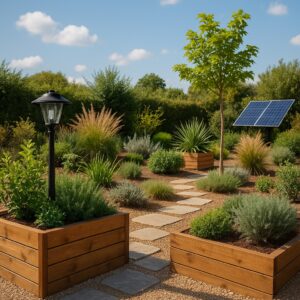
Introduction to Sustainable Outdoor Design
Sustainability in outdoor design is more than a buzzword—it’s an imperative shift towards creating resilient and eco-friendly environments. As urban areas expand and environmental concerns intensify, the need for integrating sustainable practices in landscaping has never been more critical. In this journey towards sustainability, both aesthetics and ethics play pivotal roles. By consciously utilizing resources and intelligently designing spaces, we align with a new vision that respects the Earth’s finite resources.
The allure of sustainable design lies in its balance—melding nature with architecture. Whether you are envisioning a verdant escape or sleek hardscape architecture, the opportunity to craft spaces that pay homage to the planet is substantial. This article delves into multiple facets of sustainable landscaping, guiding you through techniques that promise both appeal and environmental integrity.
The Benefits of Sustainable Landscaping
Sustainable landscaping yields a myriad of benefits that extend beyond mere aesthetics. At its core, it significantly mitigates environmental impact. By capitalizing on native vegetation and sustainable practices, such designs foster healthier ecosystems that thrive without excessive intervention. This natural harmony leads to a decrease in carbon emissions and a boost in local biodiversity, fostering a support system for various forms of wildlife. According to hardscape expert, Blue Oak Patios & Landscape, integrating eco-friendly materials and efficient land use also contributes to more resilient outdoor spaces.
Economically, sustainable landscapes present long-term savings. Initial investments in eco-friendly materials and technologies often pay off within a few years, with reduced utility bills and maintenance costs. Additionally, an environmentally friendly garden can enhance property value, a compelling incentive for eco-conscious homeowners. On a social level, these green spaces foster community interaction and well-being, offering places of refuge in urban jungles and promoting mental health.
Choosing Eco-Friendly Materials
The foundation of any sustainable outdoor space lies in the materials chosen. Favoring recycled and renewable materials such as composite decking, reclaimed wood, and bamboo can significantly reduce the ecological footprint. These materials not only decrease the demand for new resources but also fit into diverse design aesthetics, from rustic to contemporary.
Innovative material choices often come with the added benefits of durability and low maintenance. For instance, using permeable paving materials helps manage stormwater effectively, reducing the runoff and allowing water to naturally infiltrate the ground, thereby recharging local aquifers. Such thoughtful integrations result in outdoor spaces that are adaptable and resilient, ready to face environmental changes head-on.
Water Conservation Strategies
Water conservation is a foundation of sustainable landscaping. In an era where water scarcity is becoming increasingly common, efficient water management practices are crucial. Implementing techniques such as rainwater harvesting allows the collection and use of natural precipitation for irrigation purposes. This conserves municipal water and reduces costs associated with watering landscapes.
Drip irrigation systems are another efficient method, delivering water directly to the roots where it is needed most, minimizing evaporation and runoff. Xeriscaping, a landscaping method that uses drought-resistant plants, is gaining popularity, especially in arid regions. These strategies, endorsed by the Environmental Protection Agency, exemplify sustainable water management by allowing gardens to flourish while minimizing environmental impact.
Native Plants and Biodiversity
Incorporating native plants is a profound way to enhance biodiversity in outdoor spaces. Native plants are adapted to local climates, requiring less water, fertilizers, and pesticides. This makes them a practical choice for sustainable landscaping, helping to conserve local water resources and reduce chemical runoff.
Beyond practicality, native plants play a vital role in supporting local ecosystems. They provide food and habitat for native wildlife species, promoting healthy ecological relationships. By choosing diverse native species, gardeners can create vibrant landscapes that serve as biodiversity hotspots, contributing actively to the conservation of rare and endangered species.
Solar and Renewable Energy Solutions
The inclusion of solar and other renewable energy solutions in outdoor spaces marks an important step towards sustainability. Solar-powered lights and water features harness renewable energy, drastically reducing reliance on conventional power sources. Installing solar panels to power outdoor amenities allows for significant energy savings while reducing the carbon footprint.
Moreover, integrating wind or geothermal energy solutions can further enhance the eco-friendliness of your landscape. These technologies, though initially expensive, provide long-term savings and align with a green lifestyle. By embracing renewable energy, one can turn an ordinary garden into a powerhouse of sustainability, capable of sustaining its needs independently.
Maintenance Tips for Sustainable Spaces
Maintaining sustainable outdoor spaces involves adopting eco-friendly practices that nurture the environment. Natural pest management, utilizing beneficial insects like ladybugs, reduces the need for harmful pesticides. This approach not only protects plants but also ensures the safety of wildlife and beneficial soil organisms.
Additionally, seasonal management practices like composting plant waste and mulching help enhance soil fertility and retain moisture, reducing the need for chemical fertilizers. These practices create a self-sustaining cycle, minimizing external resource input and ensuring the long-term health of the landscape.
Conclusion: The Future of Sustainable Outdoor Living
As we strive towards greener solutions, the role of sustainable outdoor spaces becomes ever more crucial. These landscapes not only enrich our lives aesthetically but also play a significant role in conserving natural resources and supporting ecological balance. By adopting sustainable methods, we set a precedent for future generations, ensuring that our Earth remains vibrant and life-supporting for years to come.
The future of outdoor spaces is bright and green, with endless possibilities for integrating technology and nature seamlessly. As designers and homeowners embrace these practices, the impact extends beyond individual gardens to a global scale, moving us closer to a sustainable and harmonious world.




